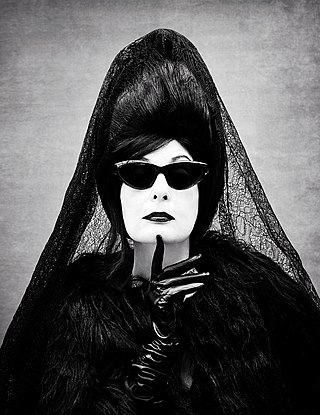The Lebu are a subgroup of Wolof in Senegal, West Africa, living on the peninsula of Cap-Vert, site of Dakar. The Lebu are primarily a fishing community, but they have a substantial business in construction supplies and real estate. They speak Lebu Wolof, which is closely related to Wolof proper but is not intelligible with it.

Sonia Rykiel was a French fashion designer and writer. She created the Poor Boy Sweater, which was featured on the cover of French Elle magazine. Her knitwear designs and new fashion techniques led her to be dubbed the "Queen of Knits". The Sonia Rykiel label was founded in 1968, upon the opening of her first store, making clothing, accessories, and fragrances. Rykiel was also a writer, and her first book was published in 1979. In 2012, Rykiel revealed that she was suffering from Parkinson's disease. She died from complications of the disease on 25 August 2016.

Chloé is a French luxury fashion house founded in 1952 by Gaby Aghion. In 1953, Aghion joined forces with Jacques Lenoir, formally managing the business side of the brand, allowing Aghion to purely pursue the creative growth of Chloé. Its headquarters are located in Paris.

Mikhaila "Coco" Rocha is a Canadian model. She is known as one of the first "digital" supermodels, and is known for her advocacy for younger models. As an author, she collaborated on the 2014 book Study of Pose. Rocha is also the founder of the Coco Rocha Model Camp and co-owner of the Nomad Management Modeling Agency.

Paris Fashion Week is a series of designer presentations held semi-annually in Paris, France, with spring/summer and autumn/winter events held each year. Dates are determined by the Fédération de la Haute Couture et de la Mode. Paris Fashion Week is held at venues throughout the city.

Jayne Pierson is a Welsh fashion designer. She launched her début collection with On|Off at London Fashion Week in September 2009. She has designed for Alexander McQueen and Vivienne Westwood. Her speciality is designing fashions for artists and actors.
Mdvanii was originally conceived as a conceptual art and fashion doll for adults by artist BillyBoy*. Since 1990, it has been a collaboration with his life partner, artist Jean Pierre Lestrade. The 25-centimetre (9.8 in) tall doll was originally made in a matte Caron make-up toned hard resin. Mdvanii debuted on February 14, 1989 in London, England.

Diane Pernet is a Paris-based American-born international fashion blogger and critic and founder of the international ASVOFF festival.

ASVOFF, or A Shaded View on Fashion Film, is a fashion film festival founded by journalist Diane Pernet. Since its 2008 debut at the Jeu de Paume National Gallery, it is a three-day festival event showcasing feature films, documentaries, conferences, performances and installations.
Sarah Jane Burton is an English fashion designer. She worked at the Alexander McQueen fashion house from 1997 through 2023, spending her last 13 years at the company as its creative director. She is currently the creative director of Givenchy.

Women in Senegal have a traditional social status as shaped by local custom and religion. According to 2005 survey, the female genital mutilation prevalence rate stands at 28% of all women in Senegal aged between 15 and 49.

Xiao Wen Ju is a Chinese model. She was the first model of Chinese descent to be the face of Marc Jacobs.
Angèle Diabang Brener is a Senegalese screenwriter, director and film producer.
Patricia Cleveland is an American fashion model who initially attained success in the 1960s and 1970s and was one of the first African-American models within the fashion industry to achieve prominence as a runway model and print model.
Marpessa Hennink is a Dutch fashion model. She is best known for her work as a runway model, which earned her the moniker “The Catwalk Contessa”.
Lady Dior is a commercial name given to a handbag by the Christian Dior company in honor of Diana, Princess of Wales. It was designed by Gianfranco Ferré in 1994 under the name Chouchou, and was later renamed as Princesse before being renamed as Lady Dior. French actress Marion Cotillard was the ambassador of Lady Dior for nine years, from 2008 to 2017, even designing her own handbag for the brand in 2012.

Maria Grazia Chiuri is an Italian fashion designer. After stints working at Fendi and Valentino, Chiuri was named creative director at Dior in 2016.
Fatoumata Diabaté is a Malian photographer from Bamako.
Lucie de la Falaise is a Welsh-born French design consultant, former model, and socialite.
Ali Karoui, born in 1986 in Tunis, is a Tunisian fashion designer and founder of Ali Karoui Coutures.










